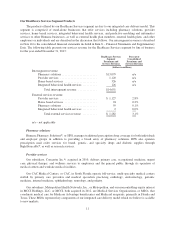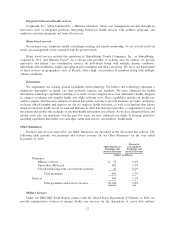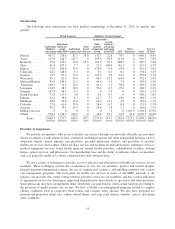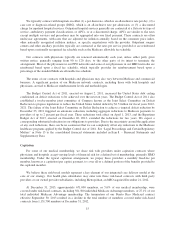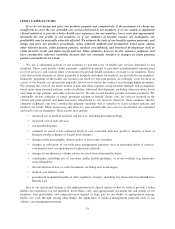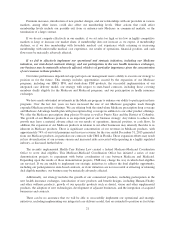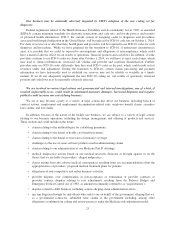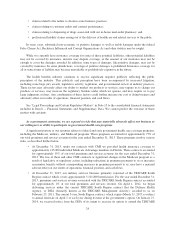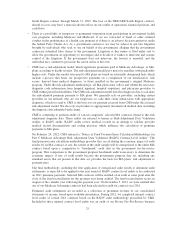Humana 2013 Annual Report Download - page 31
Download and view the complete annual report
Please find page 31 of the 2013 Humana annual report below. You can navigate through the pages in the report by either clicking on the pages listed below, or by using the keyword search tool below to find specific information within the annual report.Premium increases, introduction of new product designs, and our relationships with our providers in various
markets, among other issues, could also affect our membership levels. Other actions that could affect
membership levels include our possible exit from or entrance into Medicare or commercial markets, or the
termination of a large contract.
If we do not compete effectively in our markets, if we set rates too high or too low in highly competitive
markets to keep or increase our market share, if membership does not increase as we expect, if membership
declines, or if we lose membership with favorable medical cost experience while retaining or increasing
membership with unfavorable medical cost experience, our results of operations, financial position, and cash
flows may be materially adversely affected.
If we fail to effectively implement our operational and strategic initiatives, including our Medicare
initiatives, our state-based contracts strategy, and our participation in the new health insurance exchanges,
our business may be materially adversely affected, which is of particular importance given the concentration
of our revenues in these products.
Our future performance depends in large part upon our management team’s ability to execute our strategy to
position us for the future. This strategy includes opportunities created by the expansion of our Medicare
programs, including our HMO, PPO, and stand-alone PDP products, the successful implementation of our
integrated care delivery model, our strategy with respect to state-based contracts, including those covering
members dually eligible for the Medicare and Medicaid programs, and our participation in health insurance
exchanges.
We have made substantial investments in the Medicare program to enhance our ability to participate in these
programs. Over the last few years we have increased the size of our Medicare geographic reach through
expanded Medicare product offerings. We are offering both the stand-alone Medicare prescription drug coverage
and Medicare Advantage health plan with prescription drug coverage in addition to our other product offerings.
We offer the Medicare prescription drug plan in 50 states as well as Puerto Rico and the District of Columbia.
The growth of our Medicare products is an important part of our business strategy. Any failure to achieve this
growth may have a material adverse effect on our results of operations, financial position, or cash flows. In
addition, the expansion of our Medicare products in relation to our other businesses may intensify the risks to us
inherent in Medicare products. There is significant concentration of our revenues in Medicare products, with
approximately 74% of our total premiums and services revenue for the year ended December 31, 2013 generated
from our Medicare products, in particular our contracts with CMS in Florida. These expansion efforts may result
in less diversification of our revenue stream and increased risks associated with operating in a highly regulated
industry, as discussed further below.
The recently implemented Health Care Reform Law created a federal Medicare-Medicaid Coordination
Office to serve dual eligibles. This Medicare-Medicaid Coordination Office has initiated a series of state
demonstration projects to experiment with better coordination of care between Medicare and Medicaid.
Depending upon the results of those demonstration projects, CMS may change the way in which dual eligibles
are serviced. If we are unable to implement our strategic initiatives to address the dual eligibles opportunity,
including our participation in state-based contracts, or if our initiatives are not successful at attracting or retaining
dual eligible members, our business may be materially adversely affected.
Additionally, our strategy includes the growth of our commercial products, including participation in the
new health insurance exchanges, introduction of new products and benefit designs, including HumanaVitality
and other wellness products, growth of our specialty products such as dental, vision and other supplemental
products, the adoption of new technologies, development of adjacent businesses, and the integration of acquired
businesses and contracts.
There can be no assurance that we will be able to successfully implement our operational and strategic
initiatives, including implementing our integrated care delivery model, that are intended to position us for future
21


